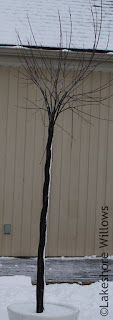Wednesday morning, June 20th at 6 am Jennifer, Frances and I began our 13 hour drive from Strathroy, Ontario to Decorah, Iowa to participate in 4 days of willow classes.
The Willow Gathering was arranged by Jo Campbell-Amsler of Willow Ridge Basketry, Monticello, Iowa and Lee Zieke Lee of Willowglen Nursery, Decorah, Iowa and took place at the wonderful venue of Luther College, Decorah.

I was told that Decorah started as a Norwegian settlement as the landscape to a certain extent resembled their Scandinavian homeland - and still 2/3 of the population has Norwegian roots.
The college is built with a lot of reference to Scandinavian design and lifestyle.

The residences that we stayed at were wonderful 4 or 6 bedroom houses close to the Shirley Baker Commons where the classes were held.
The housing sections all had Norwegian names – we stayed at Trondheim.

The photos in this post are all from the classes that I participated in: 2 two day classes with Katherine Lewis of Dunbar Gardens Willow Baskets, Mount Vernon, WA
The beautiful hat (fashionista) was made by Donna Kallner of Donna Kallner Fiber Art and it is made with silk dyed with willow. Donna Kallner taught 2 two day classes in fiber art using willow for coiling and for dying silk.
The third teacher who taught at the gathering (there were other willow basket teachers at the gathering, but not teaching here) was Sandy Whalen, Milford, Michigan. Please see information about Sandy Whalen on Jo Campbell-Amsler’s web-site, under information about the Willow Gathering as I cannot find more detailed information about Sandy Whalen on-line.


I was happy to learn a couple of new techniques by Katherine Lewis.
Our first basket was a “rope coil” basket, the technique developed by the Danish basket maker Klaus Titze who calls them “rolling baskets”.
On the left is a photo of our almost finished baskets and my finished basket in the photo on the right. I really like the look of this technique and it can be applied to lots of different shapes – also larger outdoor work as for example a woven fence.

The technique for the magazine basket is also new for me. A scallom is cut at the end of the stakes before they are attached to the base which is woven on an oval ring. I like the end result – although I have to admit that I am a bit “knife shy” so the cutting process was somewhat slow for me.
the base which is woven on an oval ring. I like the end result – although I have to admit that I am a bit “knife shy” so the cutting process was somewhat slow for me.
The coracle in the photo at the right was launched in one of the ponds on campus and Poppy Hatinger – who has been involved in a couple of coracle projects – had a lovely presentation for us about the world of coracles and how to make them. Donna Kallner has a few blog postings about it here.
A wonderful trip – worth all the kilometers – spending days with other willow basket makers, teachers, students in beautiful surroundings, learning and making new friends and valuable contacts.
 Next week-end is the Christmas HandMade Market and this year the event will take place in two locations. I will be at Fielding Estate Winery.
Next week-end is the Christmas HandMade Market and this year the event will take place in two locations. I will be at Fielding Estate Winery. In addition to my bird feeders, different styles of baskets, lanterns etc I will have many Christmas themed items such as angels, stars, cones, hearts, Christmas trees and more for you.
In addition to my bird feeders, different styles of baskets, lanterns etc I will have many Christmas themed items such as angels, stars, cones, hearts, Christmas trees and more for you. 












































